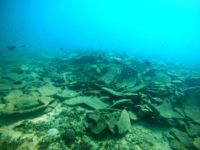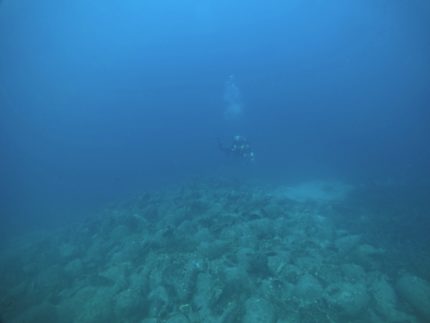 For decades the prospect of looters and even well-meaning recreational divers damaging Greece’s vast underwater cultural patrimony made SCUBA diving illegal in Greek waters. Since 2005 diving has been allowed but only in very restricted circumstances, mainly to archaeological teams excavating ancient shipwreck sites. A new initiative under the BLUEMED program will now open ancient shipwrecks to the public who will be able to explore the sites via guided diving.
For decades the prospect of looters and even well-meaning recreational divers damaging Greece’s vast underwater cultural patrimony made SCUBA diving illegal in Greek waters. Since 2005 diving has been allowed but only in very restricted circumstances, mainly to archaeological teams excavating ancient shipwreck sites. A new initiative under the BLUEMED program will now open ancient shipwrecks to the public who will be able to explore the sites via guided diving.
The first site to open is a 5th century B.C. wreck found near the uninhabited island of Peristera opposite the island of Alonissos. When the Peristera wreck was discovered and excavated in the early 1990s, it upended the historical understanding of ancient Greek shipping. Before this discovery, historians thought the largest merchant ships in Greece were built by the Romans in the 1st century B.C. and were no more than 70 tons carrying 1,500 amphorae. The Peristera ship was huge at 126 tons, the largest ship of the Classical era ever found in the Aegean, and it carried a cargo of more than 4,000 amphorae (that we know of; there was almost certainly other cargo on board that has not been found).
Thousands of ancient vases, the vast majority intact, lie in layers. Fish, sponges and other sea creatures have made the amphoras their home, adding color and life to the site. In some places, the cargo towers above divers as they pass along the perimeter of the wreck.
“It is very impressive. Even I, who have been working for years in underwater archaeology, the first time I dived on this wreck I was truly impressed,” said Dimitris Kourkoumelis, the lead archaeologist on the project preparing the site for visitors. “It’s different to see amphoras … individually in a museum and different to see them in such concentration.”
While any exposed wood of the ship itself has rotted away, the great mounds of amphorae surviving in situ make for an incredibly dramatic vista in a setting of great natural beauty within the National Marine Park of the Northern Sporades. Three other shipwrecks in the West Pagasitikos area have been selected as pilot sites for the tour program by Greece’s Ministry of Culture and Sports.
To prepare these locations for diving tours, Ephorate of Antiquities experts inspected the shipwrecks, cleaning them of trash and any modern interventions, documenting their current condition and status in exhaustive detail and designating “microregions” of the underwater archaeological monuments to serve as diving tour routes. The wrecks and topology of the seabed were surveyed with 3D scans and high-resolution photogrammetry performed by autonomous submarine vehicles. The ecology of the sites were also mapped and documented with a particular focus on the biodiversity of the marine environment.
The first of the guided tours took place last weekend with small groups of divers. The boat departed from the harbor of Steni Valla on Alonissos for the short trip to the Peristera wreck. During the jaunt on the boat, tour guides gave the visitors a rundown of the historical context of the shipwreck they were about to explore. Informational panels positioned along the perimeter of the site itself provided more explanation of what they were seeing.
“It was an amazing opportunity … to dive at last on an ancient wreck,” said Kostas Menemenoglou, a 39-year-old recreational diver from the central town of Volos. “It was a fantastic experience. It’s really like diving into history.”

Alonissos was known as Ἴκος back then. Apparently, it was colonists from Crete in the 16th century BC who started wine making on the island(s?).
There were several workshops for amphorae, and (some) pots bore the inscription ‘Made in Ikos’ or “IKION”, thus, were clearly intended for (wine) export. On Crete there are e.g. also olives/ oil and almonds, but possibly not on Alonissos.
Maybe, but only maybe, there was a reverse vending system in place for returnable amphorae, and unfortunately they sank so close to home :no:
There’s more than one way to have deposit on a bottle!
Maybe it was the 4000th amphora that ‘broke the ship’s back’.
It was an amazing opportunity.